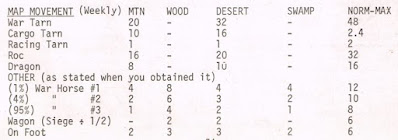When I looked previously at the Lake Gloomy material (HERE) from early summer 1972, I focused on organizing the material in a user friendly manner. The presentation of Arneson's Loch Gloomin material in the FFC seems as if it was typed directly from his notes with little thought of clarity for the reader.
The focus of this posts relates to the actual nature of the game which the notes describe, that being what we might today label as a sandbox hexcrawl.
For the first year of gaming in the Northern Marches, play had focused in and around Blackmoor Castle and town surroundings, with perhaps the occasional foray north to Glendower.
With the exile of a significant portion of the Blackmoor PC's into the western swamp town of Loch Gloomin aka Lake Gloomy, a whole new chapter opened up, and it was a chapter without a large central dungeon.
Yes, there was still a town to call home base, but the town itself did not have an underworld full of treasure. One had to go out in the world to find gold. Arneson was forcing his players to explore the world beyond the dungeon.
In creating Lake Gloomy, Arneson was again creating a whole new kind of gaming - the Hexcrawl, and mind you this was months before Outdoor Survival was released.
He set the area up on a 10 * 10 miles per square grid with Loch Gloomen at the center, as if the whole were a wargame board. Then he determined there would be "Twelve Special areas located in random directions... and distances..." (FFC 77:86)
He then created the tables and rolled the rolls to determine exactly what those "special areas" would be, such as haunted cemeteries, abandoned mansions, monster-filled cave complexes and so on - all as detailed in the previous post linked above.
Further, he employed rules he created for overland travel, probably made earlier, but if not, certainly by this time - the same travel rules that morphed into those of D&D as I explained in this post on the 18 pages of notes (HERE). Rates are in 10 mile squares. (FFC 77:34)
Likewise rules for wilderness wandering monsters, as seen here (and previously discussed HERE), which again formed the bases of those in D&D, at least in the categories. (FFC 77:34)
One square at a time (usually), Arneson's players could move out of the town and find what adventures may await them. Being outdoors and unconstrained by walls and tunnels, this new kind of adventuring was entirely different from dungeon dives yet it was built on several of the same principles in dungeon design and stocking Arneson had already worked out. The wilderness, in a sense, was a horizontal dungeon level on a larger time and distance scale, but it was free and open in ways a dungeon never could be. In developing the Loch Gloomin hexcrawl Arneson created methods that allowed his players to explore the world - methods used by gamemasters to this day.



1 comments:
Fantastic post - thanks!
A great example of how Arneson's Blackmoor campaign set the template for the D&D Basic/Dungeon, Expert/Wilderness paradigm.
(...and even the Companion/Domain game using the Blackmoor bunch, as you've explained in previous posts!)
Post a Comment